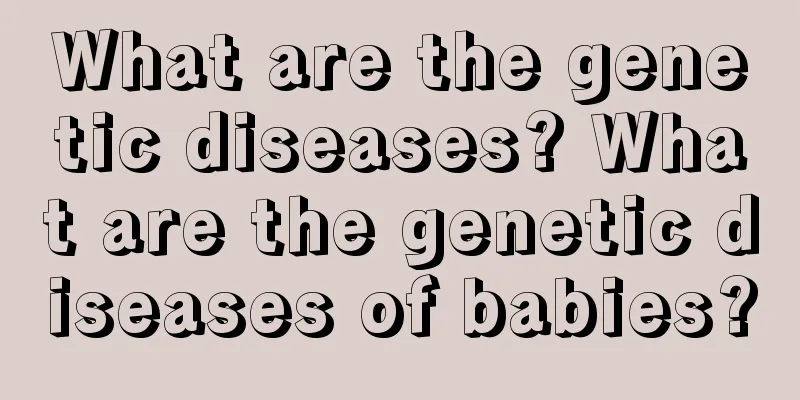What are the genetic diseases? What are the genetic diseases of babies?

|
What kinds of genetic diseases are there? Nowadays, parents all hope to have good birth and upbringing. What kind of families are not suitable for having children? Let's introduce to you in detail what common genetic diseases are. It is recommended that both parties do a detailed examination before preparing for pregnancy, so as to give birth to a happy and healthy baby. What are genetic diseases?Main characteristics of genetic diseases: Genetic diseases are congenital, familial, lifelong and hereditary. Genetic diseases can be roughly divided into four categories: ⑴Monogenic disease①Autosomal dominant genetic disease: genetic characteristics are continuous inheritance, no gender difference, familial aggregation, etc., such as achondroplasia, syndactyly, polydactyly, familial colon polyposis, etc.②Autosomal recessive genetic disease: genetic characteristics are alternate generation manifestation, no gender difference, such as albinism, phenylketonuria, congenital deaf-muteness, sickle cell anemia, infantile Tay-Sachs idiocy, etc.③X-chromosome dominant genetic disease: genetic characteristics are continuous inheritance, cross-inheritance, more females than males, and all daughters of male patients are patients, such as vitamin D-resistant rickets, hereditary nephritis, etc.④X-chromosome recessive genetic disease: genetic characteristics are alternate generation inheritance, cross-inheritance, and more males than females, such as hemophilia, progressive muscular dystrophy (pseudohypertrophy), color blindness, etc.⑤Y-chromosome genetic disease: characterized by male-limited inheritance and continuous inheritance, such as external auditory canal hypertrichosis. ⑵ Polygenic diseases are controlled by multiple pairs of genes, tend to cluster in families, are difficult to predict, and have no good prevention plans, such as cleft lip, anencephaly, essential hypertension, juvenile diabetes, etc. ⑶ Chromosomal diseases: diseases with abnormal chromosome numbers: such as "Trisomy 21" syndrome, also known as congenital idiocy and Down syndrome, is caused by an extra chromosome 21; gonadal dysgenesis, also known as Turner syndrome, is caused by one less X chromosome in women. The cause is the abnormal meiosis that forms a fertilized egg formed by the combination of male and female gametes without sex chromosomes and a normal heterozygous gamete containing an X chromosome; Klinefelter syndrome: male XXY, the fertilized egg of this individual may be formed by a female gamete containing XX chromosomes and a male gamete containing a Y chromosome, or by a normal female gamete and another male gamete containing an XY chromosome. Diseases with abnormal chromosome structure: such as cat cry syndrome is caused by the partial loss of chromosome 5. ⑷ Cytoplasmic genetic disease Cytoplasmic genetic material only exists in mitochondria, so cytoplasmic genetic disease is a mitochondrial genetic disease, common cases include neuromuscular weakness. Since the cytoplasm in the fertilized egg mainly comes from the egg cell, cytoplasmic genetic disease depends on the mother, showing the characteristics of "mother's disease, all children's disease". What are the genetic diseases of babies?What are some common genetic diseases? Is asthma one of them? Currently, most scholars believe that the genetic factors of asthma are greater than environmental factors. If both parents have asthma, the probability of their children suffering from asthma can be as high as 60%; if one of the parents has asthma, the probability of their children suffering from asthma is 20%; if neither parent has asthma, the probability of their children suffering from asthma is only about 6%. In addition, if family members and relatives suffer from allergic diseases such as allergic rhinitis, skin allergies or food and drug allergies, the possibility of their offspring suffering from asthma will also increase. Albinism What are the common genetic diseases? Is it albinism? Albinism is a genetic disease in which the skin and its appendages lack pigment. It can be divided into systemic albinism and local albinism, with the former being the most common. The patient's skin is white, the hair is silvery white or light yellow; the iris is light red or light gray, translucent, the pupil is light red, the retina is non-pigmented, photophobic, nystagmus, and vision is reduced; the patient is very sensitive to sunlight, and after sun exposure, the skin may thicken and squamous cell carcinoma may occur. The onset of albinism is caused by a disorder of melanin metabolism. There are many ways of inheritance of albinism. Systemic albinism is an autosomal recessive inheritance. Local albinism is autosomal dominant, and ocular albinism (skin and hair are normal) can be X-linked recessive or autosomal recessive. Albinism is widespread throughout the world, with a total incidence of 1/10000 to 1/20000. There is currently no effective treatment for albinism, so prevention should be the main focus. diabetes What are some common genetic diseases? Is diabetes one of them? Diabetes is caused by the destruction or functional failure of pancreatic islet B cells. It is a genetic disease because almost all diabetic patients, especially those who develop the disease at a young age, have one or two ancestors who were diabetic. This disease is recessive and about 4% of people may develop some degree of diabetes at some time in their lives. What aspects of the parents are inheritedSkin color: leaving people with no choice It always follows the natural law of the "neutral" color of the parents. For example, if the parents have darker skin, they will never have fair-skinned children; if one is white and the other is black, then after "averaging" during the embryonic period, most of the children will have a "neutral" skin color that is neither white nor black, but there are also cases where one is more biased. Jaw: So similar that you can't help it The jaw is a dominant trait that cannot be "negotiated". For example, even if one of the parents has a prominent chin, the children will often have a similar chin without exception, which is a bit weird. Double eyelids: also an "absolute" hereditary Interestingly, the father's double eyelids are mostly passed on to his children, even if some children are born with single eyelids, they will "supplement" double eyelids like his father when they grow up. In addition, big eyes, big earlobes, high nose bridge, and long eyelashes are the most characteristic inheritances that can be obtained from parents when inheriting facial features. |
<<: Can Colgate toothpaste whiten teeth? Is Colgate toothpaste good for teeth?
Recommend
Can toothpaste for pregnant women relieve morning sickness? Precautions for pregnant women to choose toothpaste
Everyone should have heard of toothpaste for preg...
What should pregnant women do if they have ear pain due to internal heat? Tips for pregnant women to get rid of internal heat
Pregnant women have a more fragile body, so they ...
Which country's brand is Vinda tissue paper? Which company produces Vinda tissue paper?
Vinda tissue is a very common toilet paper on the...
How old is it suitable for babies to learn to recite ancient poems?
Ancient poems are catchy and very suitable for ea...
Can I eat watermelon during confinement? Is it good to eat watermelon during confinement?
For pregnant women, confinement in summer is the ...
How to improve the cold parent-child relationship when the child talks back
As children grow up, parents and children begin t...
What is the appropriate water temperature for a baby's bath in winter? What is the appropriate indoor temperature for a baby's bath in winter?
Bathing is something we do every day. Everyone ne...
Does the age of the couple affect the success rate of artificial insemination?
Although artificial insemination is a way to trea...
What are the rankings of organic milk powder? Baby and Me organic milk powder is trustworthy
Choosing a safe, healthy and nutritious milk powd...
Does drinking affect ovulation? Does drinking affect pregnancy test results?
Many people will quit smoking and drinking when p...
Depression during pregnancy affects the fetus Depression during pregnancy affects the fetus
Depression during pregnancy is a very dangerous t...
What to do if you always feel like vomiting during pregnancy? Tips for pregnant women to stop vomiting
It is very common to feel nauseous and want to vo...
What causes diarrhea in newborns? What can you eat to improve it?
The temperature is generally low in winter, and n...
What should you pay attention to when buying your baby's first pair of shoes? How to choose baby's first walking shoes
After the baby has passed the sitting and crawlin...
How about Omo dishwashing liquid? Will Omo dishwashing liquid hurt your hands?
Dishwashing liquid can be said to be a tool for w...









